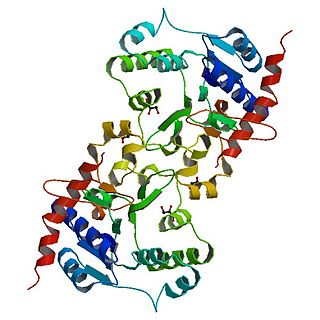
Glycogenin is an enzyme involved in converting glucose to glycogen. It acts as a primer, by polymerizing the first few glucose molecules, after which other enzymes take over. It is a homodimer of 37-kDa subunits and is classified as a glycosyltransferase.
1,3-Beta-glucan synthase is a glucosyltransferase enzyme involved in the generation of beta-glucan in fungi. It serves as a pharmacological target for antifungal drugs such as caspofungin, anidulafungin, and micafungin, deemed 1,3-Beta-glucan synthase inhibitors. Under the CAZy classification system, fungi and plant members fall in the glycosyltransferase 48 family (GT48). Some members of the glycosyltransferase 2 family, such as the curdlan synthase CrdS, also has a similar activity.
In enzymology, an alpha-1,3-glucan synthase is an enzyme that catalyzes the chemical reaction
In enzymology, an alpha-1,4-glucan-protein synthase (ADP-forming) is an enzyme that catalyzes the chemical reaction
In enzymology, an alpha,alpha-trehalose-phosphate synthase (GDP-forming) is an enzyme that catalyzes the chemical reaction
In enzymology, an alpha,alpha-trehalose-phosphate synthase (UDP-forming) is an enzyme that catalyzes the chemical reaction
In enzymology, a cellodextrin phosphorylase is an enzyme that catalyzes the chemical reaction

The UDP-forming form of cellulose synthase is the main enzyme that produces cellulose. Systematically, it is known as UDP-glucose:(1→4)-β-D-glucan 4-β-D-glucosyltransferase in enzymology. It catalyzes the chemical reaction:
In enzymology, a dolichyl-phosphate beta-glucosyltransferase is an enzyme that catalyzes the chemical reaction
In enzymology, a flavanone 7-O-beta-glucosyltransferase is an enzyme that catalyzes the chemical reaction
In enzymology, a flavone 7-O-beta-glucosyltransferase is an enzyme that catalyzes the chemical reaction
In enzymology, a linamarin synthase is an enzyme that catalyzes the chemical reaction
In enzymology, a lipopolysaccharide glucosyltransferase I is an enzyme that catalyzes the chemical reaction
In enzymology, a N-acetylglucosaminyldiphosphoundecaprenol glucosyltransferase is an enzyme that catalyzes the chemical reaction
In enzymology, a NDP-glucose—starch glucosyltransferase is an enzyme that catalyzes the chemical reaction
In enzymology, a N-hydroxythioamide S-beta-glucosyltransferase is an enzyme that catalyzes the chemical reaction

In enzymology, a starch synthase is an enzyme that catalyzes the chemical reaction

Sucrose-phosphate synthase (SPS) is a plant enzyme involved in sucrose biosynthesis. Specifically, this enzyme catalyzes the transfer of a hexosyl group from uridine diphosphate glucose (UDP-glucose) to D-fructose 6-phosphate to form UDP and D-sucrose-6-phosphate. This reversible step acts as the key regulatory control point in sucrose biosynthesis, and is an excellent example of various key enzyme regulation strategies such as allosteric control and reversible phosphorylation.

In enzymology, a sucrose synthase is an enzyme that catalyzes the chemical reaction
In enzymology, a xyloglucan 4-glucosyltransferase is an enzyme that catalyzes the chemical reaction in which a beta-D-glucosyl residue is transferred from UDP-glucose to another glucose residue in xyloglucan, linked by a beta-1,4-D-glucosyl-D-glucose bond.





